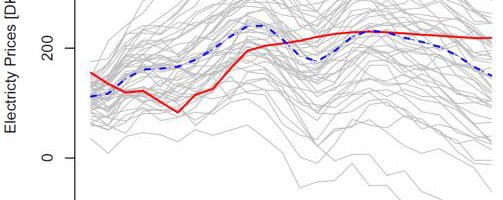Once, not so many years ago, heating water for district heating (DH) was a simple thing. In need of hot water? Turn on the boilers! At that time, the boilers used fossil fuels, but modern heating systems use a variety of fuels, including natural gas and biomass as well as electricity and, solar power.
This flexibility offers economic advantages, as choosing the right heating technology at the right time can save or even earn the district heat plant and customers lots of money. If electricity prices are high, use the combined heat and power (CHP) systems to heat the water and store it for later while producing electricity to sell. If the prices are low due to an abundance of i.e. wind power, use electricity to heat the water.
A challenge of the energy system is that renewable energy-sources like wind are fluctuating and not always predictable. If the weather forecast predicted strong winds, it encourages district heating plants to expect low electricity prices and therefore place large bids on electricity on the electricity markets. This can turn out costly if the wind dies down and the prices go high. Which is why most district heating operators adopt a better-safe-than-sorry approach to minimize loses and avoid more expensive heating.
Researchers at DTU developed a smart-decision making tool for the district heating suppliers, giving them higher flexibility to act on the day-ahead electricity market and thus the capacity to plan ahead which kind of technology, they should use in any given scenario. Wind or no wind.
“Wrong decisions are costly, so we are developing a smart-decision making tool that allows the operators at the district heating plants higher flexibility to plan ahead, opening up for taking a wait-and-see-approach”, explain PostDoc Daniela Guericke and PhD-student Ignacio Blanco, DTU Compute.
They are part of the DTU-project CITIES that aims at increasing the storage and flexibility capabilities of the Danish energy system. The demo-project “Operational planning and bidding for district heating systems” works on developing predictions and optimization methods to take different aspects of the energy market and weather into account. This enables district heating suppliers to optimize flexibility and reduce costs.
“We use a two-stage stochastic program with scenarios for the uncertainties like the electricity-prices and the production of renewable energy telling us what to do if the wind and/or the market prices change”, says Daniela Guericke.
DTU created the smart-decision making tool in cooperation with the software and consultancy company EMD International, and tested it using computer simulations based on 2017-data of the district heating supplier in Hvide Sande. The initial results are good.
“Once it was enough to just turn on the natural gas boilers when it was needed, but the current systems are now so complicated with so many choices, that we need smarter solutions to decide which technology to use. This tool introduces flexibility to the heat production system. The next step is to develop the smart-decision making tool further, so that it can be used by other district heating suppliers”, says Ignacio Blanco, DTU Compute.
Fact: District Heating
District heating (DH) is a simple technique, where water is heated using a variety of technologies using energy sources like fossil fuels, biomass, natural gas, electricity, sun to name a few, at a centralized plant and distributed to the customers through a system of insulated pipes for residential and commercial heating requirements. District heating plants can provide higher efficiencies and lower emissions than localized boilers. District heating using combined heat and power (CHP) allows production of heat by recovering heat from electricity production.




